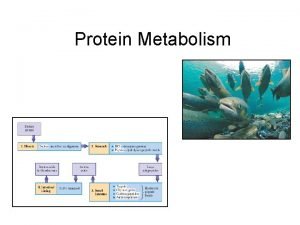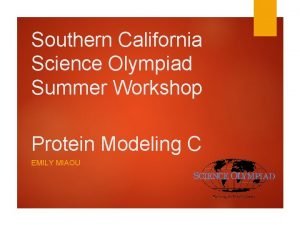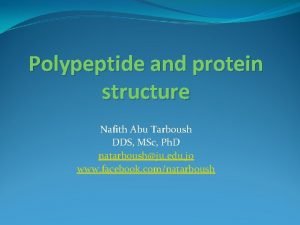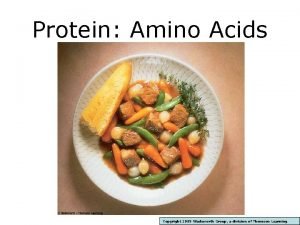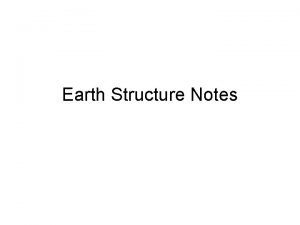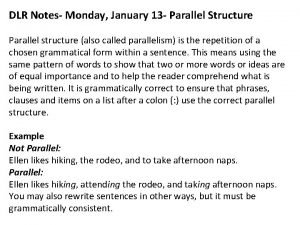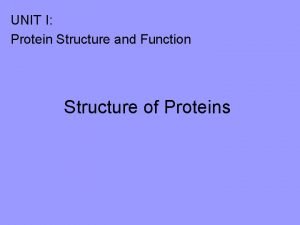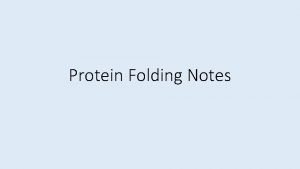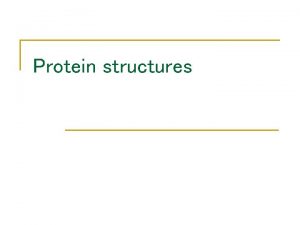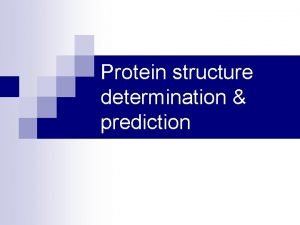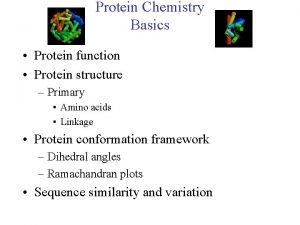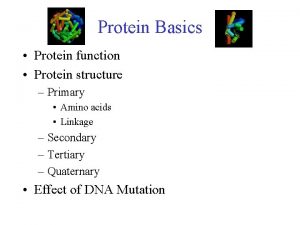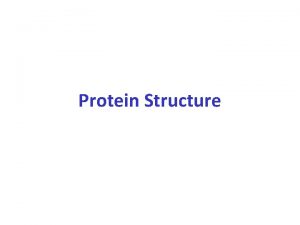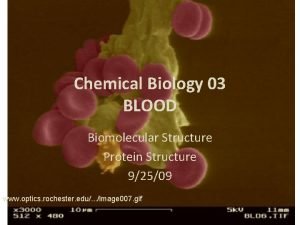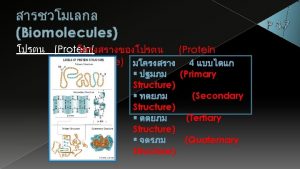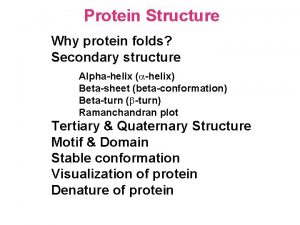Protein Notes Chemical structure of protein Protein is
















- Slides: 16

Protein Notes • Chemical structure of protein: Protein is made of chains of substances called amino acids. Proteins are organic. They contain a carboxyl group. Amino acids also contain an amine group. • An amine group is composed of two atoms of hydrogen and one atom of nitrogen (NH 2)

How amino acids link to form polypeptide bonds How do amino acids link to forma protein molecule? Through peptide bonds, bonds between the nitrogen of one amino acid and the carbon of a second amino acid. Through peptide bonds, amino acids chain together creates polypeptides.

Denaturation and coagulation of proteins • Protein shapes – rope like fibers called fibrous protein (connective tissue, collagen and elastin) • Compact protein molecules are shaped like a ball of steel wool. The round shape is globular (hemoglobin)

Denaturation • The process that changes the shape of a protein molecule without breaking its peptide bonds. Denaturation breaks the hydrogen bonds that create the twists and turns of a protein molecule

How can you denature? • Heat: This is the most common agent in denaturing protein. • By freezing, pressure and sound waves. • By mechanical treatment: such as beating eggs and kneading bread • Very high or very low p. H: adding lemon juice or vinegar. • Certain metal ions.

Proteins found in foods • Eggs, meat, fish, nut and legumes • Milk: casein is a hydrophobic protein found in milk. It is vital to forming curds in cheese making. Whey is the by-product of cheese making. It is the watery substance left behind.

Emulsifiers • The polarity of amino acids makes some protein foods good emulsifiers. Protein can stabilize an oil and water mixture. Egg yolk is an example.

Foam • Air bubbles incorporated and trapped in a protein film by whipping. Whipping introduces air and denatures the protein molecules. The protein molecules coagulate to form a fine film around the pocket of air.

Gelatin • Used to set desserts and thicken meat sauces. It is an animal protein. It is made by using heat and water to hydrolyze the collagen in the inner layer of hides and bones.

Gluten • An elastic substance formed by mixing water with the proteins found in wheat.

Texturize • The feel of protein can be changed from globular to fibrous by denaturation. Protein texturization is used in developing process cheese like Velveeta.

• Egg proteins and storage: • The shell contains protein molecules. There are pores in the shell. • The albumen or egg white makes up 54% of the inner contents of the egg. • The thickest part of the albumen is the chalaza (kuh-LAY-zuh), a twisted ropelike structure that keeps the egg yolk centers. • The yolk includes globular protein and fat.

• Eggs lose quality as compounds in the egg white break down, forming water. The white grows less viscous. Carbon dioxide and water escape through the porous shell. This can increase the p. H from a normal 7. 6 to over 9.

• Functions of proteins in the body: • Structural protein is needed by every cell in the body: collagen, ligaments, tendons, muscles. • New growth requires a continuous supply of protein to replace and repair cells. • Enzymes and hormones that are responsible for most body processes are largely proteins.

• Some proteins pick up, deliver, and store nutrients in cells. • Proteins called antibodies help you ward off diseases. • Proteins are crucial for stabilizing p. H levels. • Proteins supply energy.

Essential amino acids and complete protein: • Of the 20 amino acids the body needs to build protein, it manufactures 11. The other nine are considered essential amino acids. The body needs them but cannot make them. • A protein that contains all the essential amino acids is called a complete protein. • An incomplete protein is lacking one or more essential amino acid. • Protein allowances: RDA for a healthy adult is. 8 g of high quality protein per kilogram of ideal body mass.
 Cube wisc
Cube wisc Bilirubin bruise
Bilirubin bruise Southern california science olympiad
Southern california science olympiad Protein pump vs protein channel
Protein pump vs protein channel Protein-protein docking
Protein-protein docking Protein chemical properties
Protein chemical properties Digestion of protein in body
Digestion of protein in body Chemical reactions section 2 classifying chemical reactions
Chemical reactions section 2 classifying chemical reactions Chapter 7 chemical formulas and chemical compounds test
Chapter 7 chemical formulas and chemical compounds test Section 2 reinforcement classifying chemical reactions
Section 2 reinforcement classifying chemical reactions Section 1 chemical changes
Section 1 chemical changes What is the chemical formula for tetranitrogen heptoxide?
What is the chemical formula for tetranitrogen heptoxide? Are kc and kp equal
Are kc and kp equal Four layers of the earth
Four layers of the earth Parallel structure notes
Parallel structure notes Homework
Homework Alpha helix and beta sheet
Alpha helix and beta sheet

